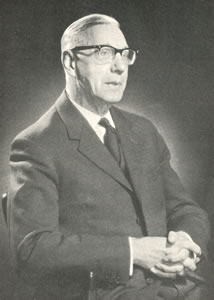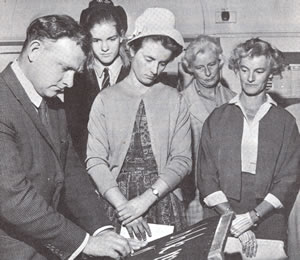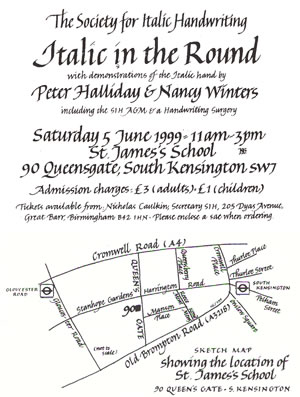Fairbank and Italic Handwriting
 Alfred Fairbank
Alfred Fairbank
The Society for Italic Handwriting was founded in 1952 but its origins lie thirty years before then. Alfred Fairbank, then a young clerk in the Admiralty, and a disciple of but not a pupil of Edward Johnston, was attending evening classes, learning to produce illuminated manuscripts, and in his leisure time becoming a calligrapher of some repute. Shortly after 1920, he noticed some sixteenth writing books on display in the Victoria and Albert Museum, and comparing the formal beauty of these manuscripts with the dullness of his ordinary civil service hand, he noted the manifest Incongruity.
These scripts, whose origins go back to the Carolingian minuscule, had developed in the papal chanceries of the Renaissance, where, when writing with a square edged pen held at about 45 degrees, certain conventions known as the 'geometry' had emerged to give a neat, rapid hand now known as humanistic cursive, which came to be widely used in educated circles of the time. As in all writing at any speed the script learned to the right, rounded letters were oval, and some were joined. The 'x-height', the body of letters like a, c, e or x was about five pen-widths tall, the ascenders and descenders of letters like b, d, g and p were a similar height, and capital letters were not quite so high.
Fairbank realised that the best qualities of these various hands could be selected and amalgamated into a simple modern hand, to give an elegant and contemporary solution to the problem of writing quickly, fluently and legibly. He called this new hand 'Italic', and in 1926 he offered notes to Robert Bridges on the principles of its design. These were published in facsimile in English Handwriting, tract no. XXVIII of the Society for Pure English. In 1932 came the first edition of his Handwriting Manual with associated writing cards. The most comprehensive exposition of his system is, however, the Beacon Writing Books, 1957 -1963.
 Kenneth Yates-Smith demonstrates Italic using edged chalk and a blackboard
Kenneth Yates-Smith demonstrates Italic using edged chalk and a blackboard
Foundation of the Society
By 1952 the Society of Scribes and Illuminators was receiving so many enquiries about italic handwriting that it was decided to set up a separate body. In November of that year the Society for Italic Handwriting came into being, whose aim was the revival of italic handwriting. The new society quickly established itself, and set about making its intentions widely known, by contacting schools and other teaching organisations and proselytising the powers that be in the educational world. Courses and workshops were instituted for those who wished to learn, and more importantly for those who wished to teach this exciting new hand. Exhibitions were mounted and travelling exhibitions were sent around the country and on occasion abroad. Books were written giving both instruction in writing and examples of fine hands.
Manufacturers of writing materials were courted, encouraged and sometimes bullied!
A Bulletin was issued which, in 1962, was renamed the Journal and a new Bulletin intended as a newssheet was inaugurated in 1982. This continued until 1993 when it was revamped as the Newsletter which in turn disappeared in 2000, to be reborn as Writing Matters.
Renewed Purpose
After a few years it was decided that the original aim of reviving italic handwriting had been achieved and that the object of the Society should be from then on should be the encouragement and promotion of the hand.
Similar organisations were soon set up on the model of the Society for Italic Handwriting in the Netherlands, the United States, Canada, Australia and South Africa; and although some of these were short-lived, and some widened their scope to become calligraphic societies, others like the Mercator Vereniging are
still flourishing.
In 1983 the Society was registered with the Charity Commission as a charity increasing its scope and responsibility and enabling to subscribe by a deed of covenant.
 Other Notable Events
Other Notable Events
- 1988: the Society stages a major handwriting exhibition at Wellingborough School
- 1992: publication of A Simple Guide to Italic Handwriting by member Nancy Winters
- 1997: Good Handwriting Initiative: a handwriting pack for use in schools
- 1997: Dimensions of Handwriting - an event celebrating handwriting
- 1998: International Dimensions of Handwriting held at the Commonwealth Institute, Kensington
- 1998: three executive committee members appear on Channel4's The Big Breakfast to promote the Society
- 1999: Italic in the Round held at 90 Queensgate, South Kensington (see advert, right)
- 2000: Writing Matters, the Society's current quarterly magazine is launched
- 2002: 50th anniversary of the Society and publication of Dance of the Pen
- 2004: Fireworks in Italic event at Westminster City College

